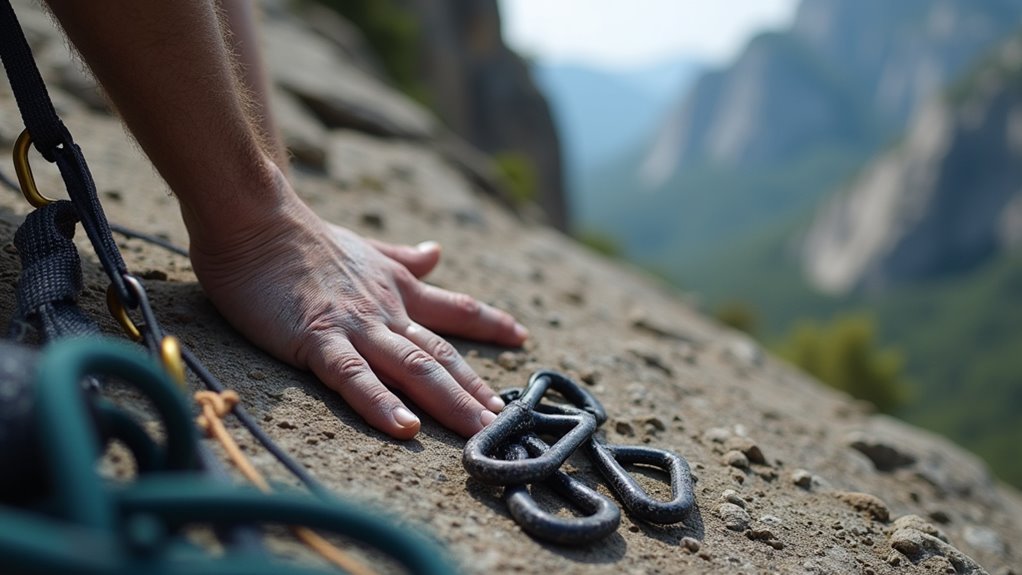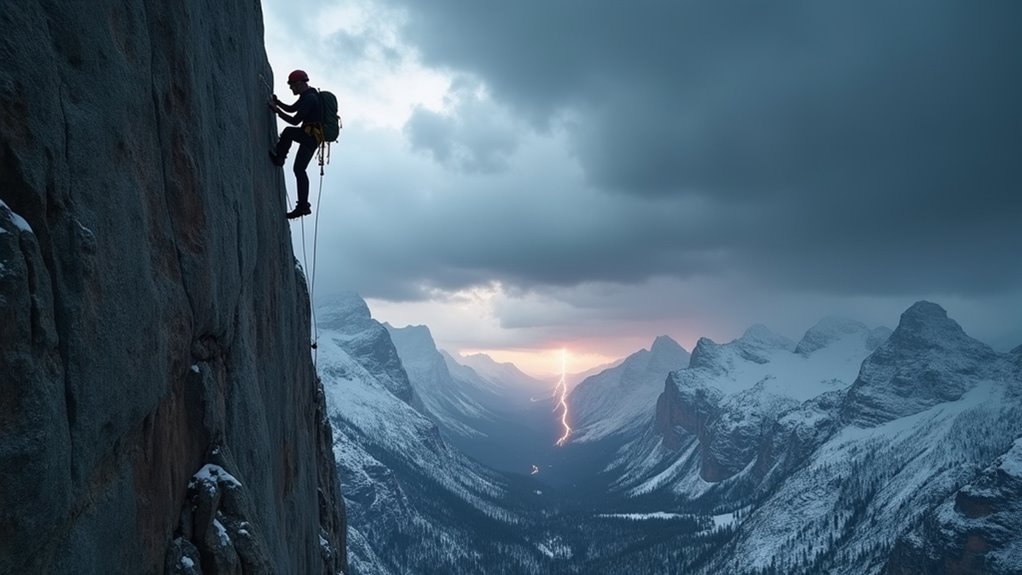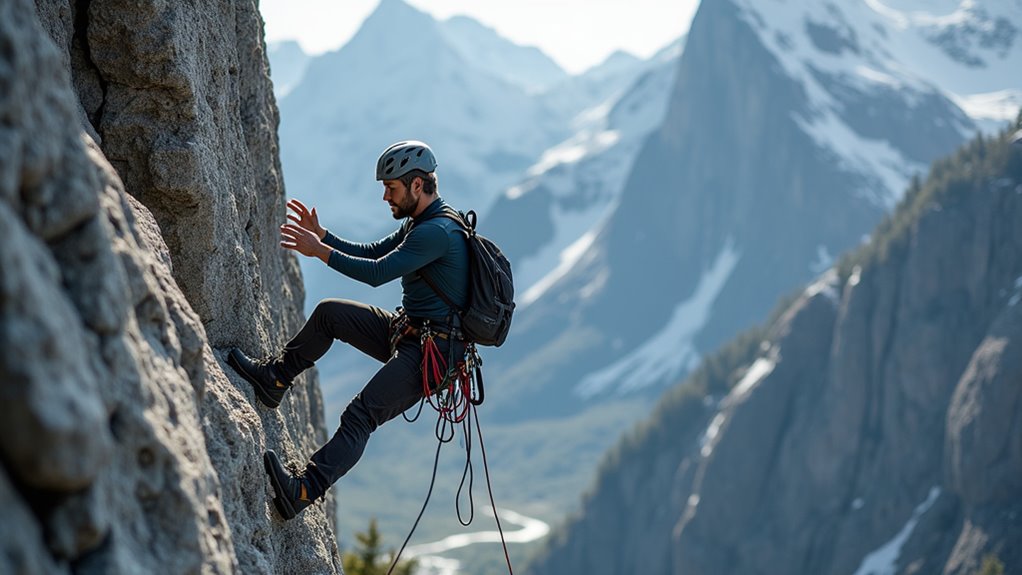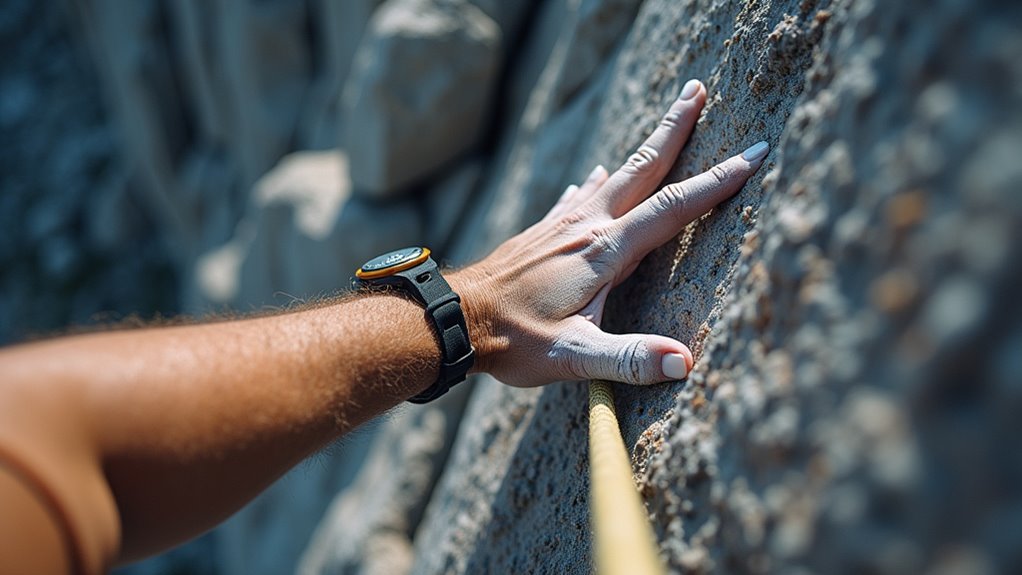Physical Address
304 North Cardinal St.
Dorchester Center, MA 02124
Physical Address
304 North Cardinal St.
Dorchester Center, MA 02124

Master climbers make fatal errors through overconfidence and complacency that novices never would—discover which deadly mistakes claim experienced lives.
Statistics show that 40% of serious climbing accidents involve climbers with over five years of experience. You’d think seasoned professionals would’ve learned to avoid basic mistakes, but that’s precisely when complacency creeps in. Even elite climbers fall victim to overconfidence, equipment oversights, and poor judgment calls that beginners wouldn’t dare make. The most dangerous moment isn’t when you’re learning—it’s when you think you’ve mastered the mountain.

Even when you’re climbing your home crag for the hundredth time, you can’t afford to get sloppy with your gear checks. Familiarity breeds complacency, and that’s when accidents happen. You know every hold, every route grade, but your harness buckle doesn’t care about your experience level if it’s not properly doubled back.
Make equipment inspection routine, not optional. Check your harness, helmet, shoes, and belay device before every session. Inspect carabiners for gate function and wear. Examine your rope for cuts, fraying, or core shots. Don’t rush through these steps because you’ve climbed here countless times.
Your regular climbing partners rely on your vigilance too. Fresh eyes catch what tired ones miss. Just like tent camping requires thorough gear preparation regardless of experience level, climbing demands the same disciplined approach to equipment safety checks.
Success on easier routes can make you feel invincible, but that confidence becomes dangerous when it pushes you toward climbs beyond your current abilities. You’ve nailed several 5.8s, so why not try that 5.11? This mindset ignores the exponential difficulty jumps between grades.
Overconfidence manifests in three critical ways:
Smart route selection means honestly evaluating today’s conditions, your current form, and the specific challenges ahead. Your past successes don’t guarantee future performance. Choose routes that challenge you appropriately while maintaining reasonable safety margins.
Just as divers must prepare thoroughly for underwater adventures, climbers need comprehensive preparation that matches their planned routes to their actual capabilities rather than their aspirations.

Weather transforms familiar routes into entirely different challenges, yet many climbers stick rigidly to their plans despite changing conditions. You’ll see experienced climbers push forward when afternoon thunderstorms roll in or when morning frost makes treacherous holds. This tunnel vision can turn routine climbs deadly.
Temperature drops affect your grip strength and rock friction. Wet conditions create slippery surfaces and increase rockfall risk. Wind can throw you off balance or make rappelling dangerous. Snow transforms approach trails into navigation nightmares.
Don’t ignore your gut when conditions deteriorate. Check forecasts before departing, but stay flexible once you’re out there. Turn back when weather shifts unexpectedly. That route will still be there next weekend, but poor decisions in bad weather create consequences you can’t undo. Before heading out, ask yourself the right questions about current conditions and your backup plans to ensure you’re making informed decisions about your climbing objectives.
While ropes and hardware get meticulous attention, the communication system between you and your partner often gets treated as an afterthought. You’ll shout commands that get lost in wind or misinterpreted through distance, creating dangerous confusion about your status or intentions.
Poor communication kills climbing partnerships and sometimes climbers. You can’t assume your partner knows what you’re thinking or planning. Critical breakdowns happen when:
Establish clear protocols before you leave the ground, not while you’re hanging from it. If you’re planning multi-day climbing adventures, consider incorporating water activities during rest days to strengthen your partnership dynamics and communication skills in a lower-stakes environment.

When your forearms feel like concrete and your brain starts making questionable route-finding decisions, that’s exactly when you need to make your most critical choice: continue or retreat.
Fatigue clouds judgment faster than weather rolls in. You’ll skip gear placements, misread holds, and ignore obvious hazards. Mental exhaustion tricks you into thinking “just one more move” when your body’s screaming otherwise.
Even seasoned climbers fall into this trap, pushing past their limits because they’re close to finishing or don’t want to disappoint partners. But tired climbers make dangerous mistakes—dropped gear, poor belaying, missed communication cues.
Recognition beats stubbornness every time. If you’re struggling with basic decisions you’d normally handle easily, it’s time to bail. The mountain isn’t going anywhere.
Just like family camping requires knowing when to call it a day for everyone’s safety and enjoyment, climbing demands the same wisdom about timing your retreat.
Beyond the mental game lies a physical reality many climbers ignore: your body needs preparation before you touch rock and recovery after you’re done. You’re setting yourself up for injury when you skip warm-ups or rush straight to your project. Even seasoned climbers fall into this trap, especially when they’re enthusiastic or pressed for time.
Your muscles, tendons, and joints require gradual activation. Cold tissues tear more easily and perform poorly. Similarly, neglecting cool-downs leaves metabolic waste in your system and promotes stiffness.
Essential components of proper climbing preparation:
These preparation principles apply whether you’re tackling indoor routes or venturing into the backcountry, where safe hiking practices become equally crucial for accessing remote climbing areas.

Since consequences amplify dramatically on certain climbs, your risk assessment skills become the difference between coming home safely and not coming home at all. Even experienced climbers sometimes rush into high-exposure routes without properly evaluating objective hazards like rockfall zones, weather windows, or escape routes.
You might focus solely on the technical difficulty while ignoring environmental factors that could prove fatal. That loose rock section you’d normally navigate without concern becomes life-threatening when you’re 2,000 feet off the deck with no quick retreat option.
Before committing to any high-consequence climb, systematically evaluate every variable: route conditions, weather forecasts, your partner’s abilities, gear redundancy, and bailout strategies. Don’t let summit fever or peer pressure override your judgment when the stakes are this high.
Understanding the 13 dangers inherent to climbing can help you develop a more comprehensive risk assessment framework that addresses both technical and environmental threats.
You’ve seen how even seasoned climbers can stumble—like Icarus flying too close to the sun with overconfidence, or Achilles forgetting that one weak spot in their armor. Don’t let familiarity breed contempt for safety protocols. Stay humble, stay vigilant, and remember that mountains don’t care about your résumé. Every climb’s a new challenge demanding fresh respect. Check your gear, trust your instincts, and never let pride write checks your skills can’t cash.